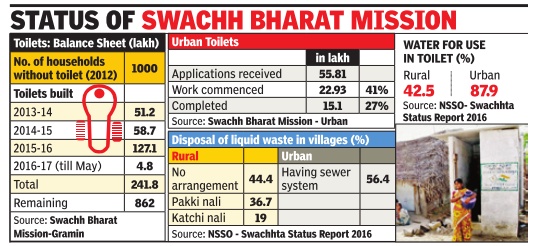Swachh Bharat Mission
This is a collection of articles archived for the excellence of their content. |
2014-16: Status
The Times of India, May 30 2016

Subodh Varma
The central government has spent Rs 9,093 crore on building about 1.8 crore toilets across the country under the Swachh Bharat Mission since October 2014.This is because Prime Minister Modi has made the drive a priority. The mission also envisages a cleaner India at large, although this part of the plan is hazy. The question that arises now is -how is this frenzy of toilet-building changing the situation on the ground? After nearly one-and-a-half years, there should be some concrete evaluation. Sadly , there is no comprehensive study . Ashok Kumar Jain, adviser in the NITI Aayog and an expert on the programme, told TOI that a study will be conducted in the coming days because the World Bank, which has given a $1.5-billion loan for the programme, wants an evaluation.
Meanwhile, the National Sample Survey Organisation (NSSO) came out with a `Swachhata Status Report' earlier this year. Findings listed in the report, especially those concerned with water use and drainage of liquid waste, give a glimpse of how the programme is performing on the ground.
According to the NSSO report, just 42.5% of rural households have “water for use in toilets“. This is a critical factor that can make or break the most well-laid plans. And, this is not something new that has been discovered recently . Decades of toilet-building have -presumably -taught policymakers that without making arrangements for water the toilets will be useless. In urban areas, the situation is vastly different with nearly 88% households having water for use in toilets.
The second critical component for use of toilets is drainage. This is often not of immediate concern to households but should be high up on the policymakers' priority list. Because the whole point of having toilets would be defeated if effluents from it are just spreading out into fields or village ponds. And this is what appears to be happening on a large scale.
The NSSO report says that a staggering 44.4% of villages have no arrangement for the disposal of liquid waste. It doesn't spell out further details as to what is happening to the toilets in these villages. It would be safe to presume that residents don't use them.
What about the remaining 55.6% of the villages? Of these, 36.7% have what the report quaintly records as a “pakki nali“ while 19% have a “katchi nali“. These are drains, one lined with concrete or bricks, the other just channels dug into the soil.And where are these “nalis“ leading to? The report says that about 16% drain into local ponds, 24% into the local “nala“, and about 7% into a local river.
The situation in urban areas is worse. Although 56.4% of households are using toilets connected to the sewer network, most of the sewage goes straight into the rivers.